
Barbara Stanwyck was an American actress, model and dancer. A stage, film, and television star, during her 60-year professional career she was known for her strong, realistic screen presence and versatility. She was a favorite of directors, including Cecil B. DeMille, Fritz Lang, and Frank Capra, and made 85 films in 38 years before turning to television.
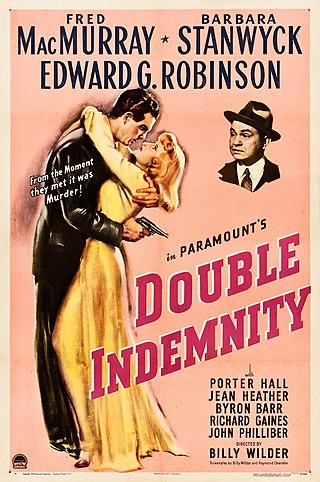
Double Indemnity is a 1944 American crime thriller film noir directed by Billy Wilder, co-written with Raymond Chandler, and produced by Buddy DeSylva and Joseph Sistrom. The film was based on James M. Cain's novella of the same name, which ran as an eight-part serial in Liberty magazine beginning in February 1936.
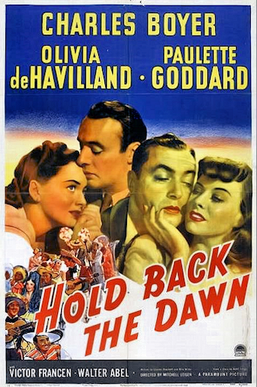
Hold Back the Dawn is a 1941 American romantic drama film directed by Mitchell Leisen, in which a Romanian gigolo marries an American woman in Mexico in order to gain entry to the United States, but winds up falling in love with her. It stars Charles Boyer, Olivia de Havilland, Paulette Goddard, Victor Francen, Walter Abel, Curt Bois, Rosemary DeCamp, and an uncredited Veronica Lake.

To Each His Own is a 1946 American romantic drama film directed by Mitchell Leisen and starring Olivia de Havilland, Mary Anderson, Roland Culver and John Lund. It was produced and distributed by Paramount Pictures. The screenplay was written by Charles Brackett and Jacques Théry. A young woman bears a child out of wedlock and has to give him up.

The Mating Season is a 1951 American comedy-drama romance film directed by Mitchell Leisen, and produced by Charles Brackett from a screenplay by Charles Brackett, Richard Breen, and Walter Reisch, based on the play Maggie by Caesar Dunn. The ensemble cast stars Gene Tierney, John Lund, Miriam Hopkins, and Thelma Ritter.
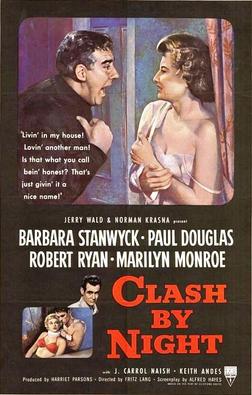
Clash by Night is a 1952 American film noir drama directed by Fritz Lang and starring Barbara Stanwyck, Paul Douglas, Robert Ryan, Marilyn Monroe and Keith Andes. The film is based on the 1941 play by Clifford Odets, adapted for the screen by writer Alfred Hayes. It is the first major film to credit Monroe before the title, albeit with fourth billing.

John Lund was an American film, stage, and radio actor who is probably best remembered for his role in the film A Foreign Affair (1948) and a dual role in To Each His Own (1946).

The Bitter Tea of General Yen is a 1933 American pre-Code drama war film directed by Frank Capra and starring Barbara Stanwyck, and featuring Nils Asther and Walter Connolly. Based on the 1930 novel of the same name by Grace Zaring Stone, the film is about an American missionary in Shanghai during the Chinese Civil War who gets caught in a battle while trying to save a group of orphans. Knocked unconscious, she is saved by a Chinese general warlord who brings her to his palace. When the general falls in love with the naive young woman, she fights her attraction to the powerful general and resists his flirtation, yet remains at his side when his fortune turns.
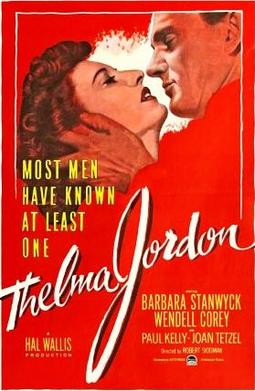
The File on Thelma Jordon is a 1950 American film noir drama film directed by Robert Siodmak and starring Barbara Stanwyck and Wendell Corey. The screenplay by Ketti Frings, based on an unpublished short story by Marty Holland, concerns a woman who pretends to fall in love with an assistant district attorney and uses him to escape conviction for the murder of her wealthy aunt.
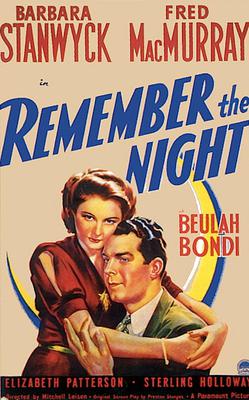
Remember the Night is a 1940 American Christmas romantic comedy trial film starring Barbara Stanwyck and Fred MacMurray and directed by Mitchell Leisen. The film was written by Preston Sturges and was the last of his scripts shot by another director, as Sturges began his own directorial career the same year with The Great McGinty.

Kati Patang is a 1971 Indian Hindi-language musical drama film produced and directed by Shakti Samanta. The film stars Asha Parekh as a woman pretending to be a widow, and her ensuing trials and tribulations opposite her charming neighbour, played by Rajesh Khanna.The film was a box office success. Parekh's performance as Madhavi was critically acclaimed and earned her the Filmfare Award for Best Actress.

Mrs. Winterbourne is a 1996 American romantic comedy-drama film starring Shirley MacLaine, Ricki Lake, and Brendan Fraser. It is loosely based on Cornell Woolrich's novel I Married a Dead Man, which had already been filmed in Hollywood as No Man of Her Own (1950) starring Barbara Stanwyck, in Hindi as Kati Patang (1970) starring Asha Parekh, and in French as J'ai épousé une ombre (1983). The film was shot on location in and around Toronto, Ontario including Eaton Hall in King City, Ontario. It was the final production of A&M Films.

You Belong to Me is a 1941 American romantic comedy film produced and directed by Wesley Ruggles and starring Barbara Stanwyck and Henry Fonda. Based on a story by Dalton Trumbo, and written by Claude Binyon, the film is about a wealthy man who meets and falls in love with a beautiful doctor while on a ski trip. After a courtship complicated by his hypochondria, she agrees to marry him on the condition that she continue to practice medicine. His jealousy at the thought of her seeing male patients, however, soon threatens their marriage. The film was released in the United Kingdom as Good Morning, Doctor, and was remade as Emergency Wedding in 1950.

The Mad Miss Manton is a 1938 American screwball comedy-mystery film directed by Leigh Jason and starring Barbara Stanwyck as fun-loving socialite Melsa Manton and Henry Fonda as newspaper editor Peter Ames. Melsa and her debutante friends hunt for a murderer while eating bonbons, flirting with Ames, and otherwise behaving like irresponsible socialites. Ames is also after the murderer, as well as Melsa's hand in marriage.

Stella Dallas is a 1937 American drama film based on Olive Higgins Prouty's 1923 novel of the same name. It was directed by King Vidor and stars Barbara Stanwyck, John Boles, and Anne Shirley. At the 10th Academy Awards, Stanwyck and Shirley were nominated for Best Actress in a Leading Role and Best Actress in a Supporting Role, respectively.

There's Always Tomorrow is a 1956 American romantic melodrama film directed by Douglas Sirk and starring Barbara Stanwyck, Fred MacMurray and Joan Bennett. The screenplay by Bernard C. Schoenfeld was adapted from the novel of the same name by Ursula Parrott. The plot concerns a man's unhappiness with his domestic life and romantic relationship with a former employee. The film was produced by Ross Hunter for Universal Pictures, which had also produced the 1934 adaptation of Parrott's novel. It was released in the United States on January 8, 1956.
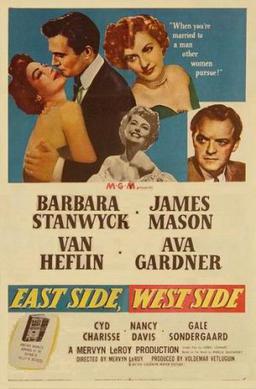
East Side, West Side is a 1949 American melodrama crime film, starring Barbara Stanwyck, James Mason, Van Heflin, and Ava Gardner. Based on the 1947 novel of the same title, written by Marcia Davenport, screenplay by Isobel Lennart, produced by Voldemar Vetluguin, directed by Mervyn LeRoy, and distributed by Metro-Goldwyn-Mayer.
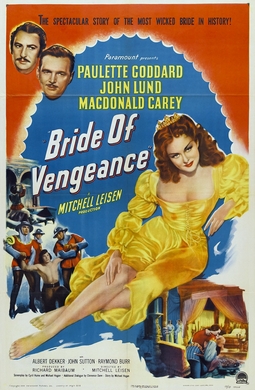
Bride of Vengeance is a 1949 American historical drama film directed by Mitchell Leisen and starring Paulette Goddard, John Lund and Macdonald Carey. Produced and distributed by Paramount Pictures, it is set in the Italian Renaissance era. Ray Milland was originally cast in the film but refused the assignment, leading the studio to suspend him for ten weeks.

All I Desire is a 1953 American drama film directed by Douglas Sirk and starring Barbara Stanwyck, Richard Carlson, Lyle Bettger, Marcia Henderson, Lori Nelson, and Maureen O'Sullivan. It is based on Carol Ryrie Brink's 1951 novel Stopover.
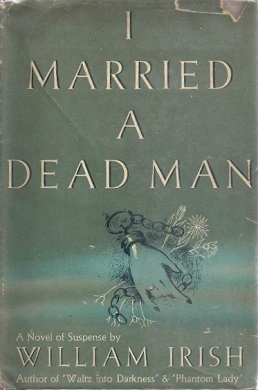
I Married a Dead Man is a 1948 novel by American crime writer Cornell Woolrich under the pseudonym William Irish.



















